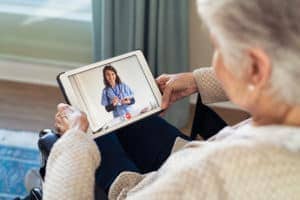According to a recent survey, more Americans are open to embracing telehealth services than ever before. It found that about one-third of people are utilizing these services each year.
With this in mind, many medical facilities are starting to extend telehealth options to patients. Some of them are also using remote patient monitoring, or RPM, to keep a closer eye on patients.
So, what is RPM? Remote patient monitoring enables doctors, nurses, and other medical professionals to monitor their patients’ blood pressure, glucose levels, and more. They’re able to provide remote health care thanks to remote patient monitoring software.
Would your medical facility like to start taking advantage of this telehealth technology? To do the proper remote health monitoring on your patients, you’ll need to invest in the latest RPM software.
Here is what the best remote patient monitoring software will include.
Easy-to-Use Interface
Patient engagement is one of the biggest challenges medical facilities face with remote patient monitoring. If patients don’t play an active role in health monitoring, it’ll be difficult for doctors, nurses, etc. to keep tabs on them. Some are hesitant to try RPM because of their technological limitations.
Because of this, remote patient monitoring software must include a very easy-to-use interface. It should be so simple to use that even the most technologically-inept patients will be able to utilize it without giving it a second thought. It’ll make them so much more likely to utilize RPM to its full potential.
Your medical facility should search for remote patient monitoring software that’ll be easy to use from the start. If it isn’t, it could prevent you from being able to set patients up with remote health care.
Medical Devices
You’ll need to provide patients with more than just remote patient monitoring software to have their health monitored. You’ll also need to be ready to set them up with medical devices that can sync with the software to track their vitals.
Some of the medical devices that patients will need to have on hand for their remote patient monitoring software will include:
- Blood pressure monitors
- Pulse oximeters
- Weight scales
- Spirometers
- And more
Much like the remote patient monitoring software itself, these medical devices will need to be very simple to use from the beginning. Your patients should be able to get the hang of using them to collect important data without putting in much effort on their part.
Cloud-Based Data Management Platform
Each of the medical devices we just alluded to will be responsible for gathering different data from patients. Your remote patient monitoring software will then need to take this data and seamlessly move it to a cloud-based data management platform.
Some of the vital signs that’ll need to be sent to this platform will include a patient’s:
- Blood pressure
- Oxygen saturation levels
- Weight
- Heart rate
- And more
More often than not, you’ll want to have patients collect this data by using medical devices at least once each day, if not more often than that. This is going to result in quite a bit of data being generated.
A cloud-based data management platform will help your facility and your patients get accurate results while using medical devices. It’ll also store the data associated with them properly and make them easily accessible for those who will need to evaluate them.
Secure Storage Mechanisms
As you very well know, you need to be very careful about how you store any data related to the health of your patients. There are strict rules and regulations in place regarding HIPAA compliance.
For this reason, it won’t be enough for remote patient monitoring software to simply collect data from patients using a cloud-based data management platform. It’ll also need to have storage mechanisms in place to keep all this valuable data safe and secure at all times.
Once your patients have transmitted data to your network, only those who need to have access to it within your medical facility should be able to get to it. The best remote patient monitoring software will see to it that it won’t be possible for others to gain access to this data at any point.
Data Analysis Tools
In a perfect world, remote patient monitoring software is going to collect so much data from patients that doctors, nurses, etc. will have a tough time keeping up with it all. At the same time, it’ll also have data analysis tools that’ll help them spot potential trends when it comes to patients’ vital signs.
There will be sophisticated algorithms in place within the software. They’ll work to identify any trends or changes that medical professionals should know about. They’ll then be able to spend all their time coming up with customized treatment plans based on what the data analysis tools tell them.
In this way, remote patient monitoring software can take a lot of the guesswork out of the equation for medical professionals. It won’t just work hard to gather data for your facility. It’ll also aim to interpret it and provide information that can play a key role in the care your patients receive.
Integrated Electronic Health Records
When making decisions related to the health of patients, medical professionals will need to have access to more than just the latest data from them. They’ll also need to be able to look back at all their health records to make the best decisions on how to treat them.
It’s why the best RPM software will have electronic health records integrated right into them. It’ll allow medical professionals to access these records easily. They can utilize them while creating customized treatment plans for patients.
This aspect of remote patient monitoring software will make it easier for medical professionals to treat patients more efficiently. They’ll spend less time looking around for health records and comparing them to the latest health data for patients. It’ll give them more time to focus on the best possible solutions to any health issues they may be having.
Real-Time Communication Tools
Medical professionals will spend their fair share of time performing remote patient monitoring without communicating with their patients. But they will obviously need to touch base with them at certain times for remote health care to work in the way it’s supposed to.
As a result, it should come as no surprise to hear that remote patient monitoring software must include real-time communication tools. It should provide both medical facilities and their patients with the opportunity to communicate in many different ways.
Here are some of the ways in which doctors, nurses, and patients should be able to communicate through this software:
- Real-time messaging
- Video conferencing
- Content sharing
At the end of the day, these communication tools should make telehealth visits feel similar to in-person visits. Medical professionals and patients should be able to get on the same page. They can discuss how they plan to move forward with treating certain health conditions.
All of this should also be done securely without putting the health-related data of patients at risk. Remote patient monitoring software should work to protect any and all communications between medical professionals and their patients.
Automated Notifications and Alerts
There may be instances in which remote patient monitoring software will pick up on alarming trends related to a person’s vital signs. In the event that this happens, both medical professionals and patients will need to know about it.
RPM software will need to provide automated notifications and alerts. It should spring into action and let doctors and patients know about the trouble that it senses.
This will be the final piece of the puzzle when it comes to providing high-quality health monitoring services. It’ll make patients feel more comfortable with using telehealth technology overall.
It’ll also make medical professionals feel like they’re more in control. They can provide patients with prompt and sometimes critical treatments without missing a beat.
Learn More About Remote Patient Monitoring Software
Do you believe your medical facility could benefit from using remote patient monitoring software? BlueStar TeleHealth can tell you more about it and talk to you about what else will be included with it.
Thousands of people are benefiting from remote patient monitoring software right now. It’s helping them keep better track of their health conditions. It’s also giving their doctors more data than they’ve been able to access in the past.
This telehealth technology can help change the way your facility provides care for your patients from now on. Contact us today to get additional information about it.




